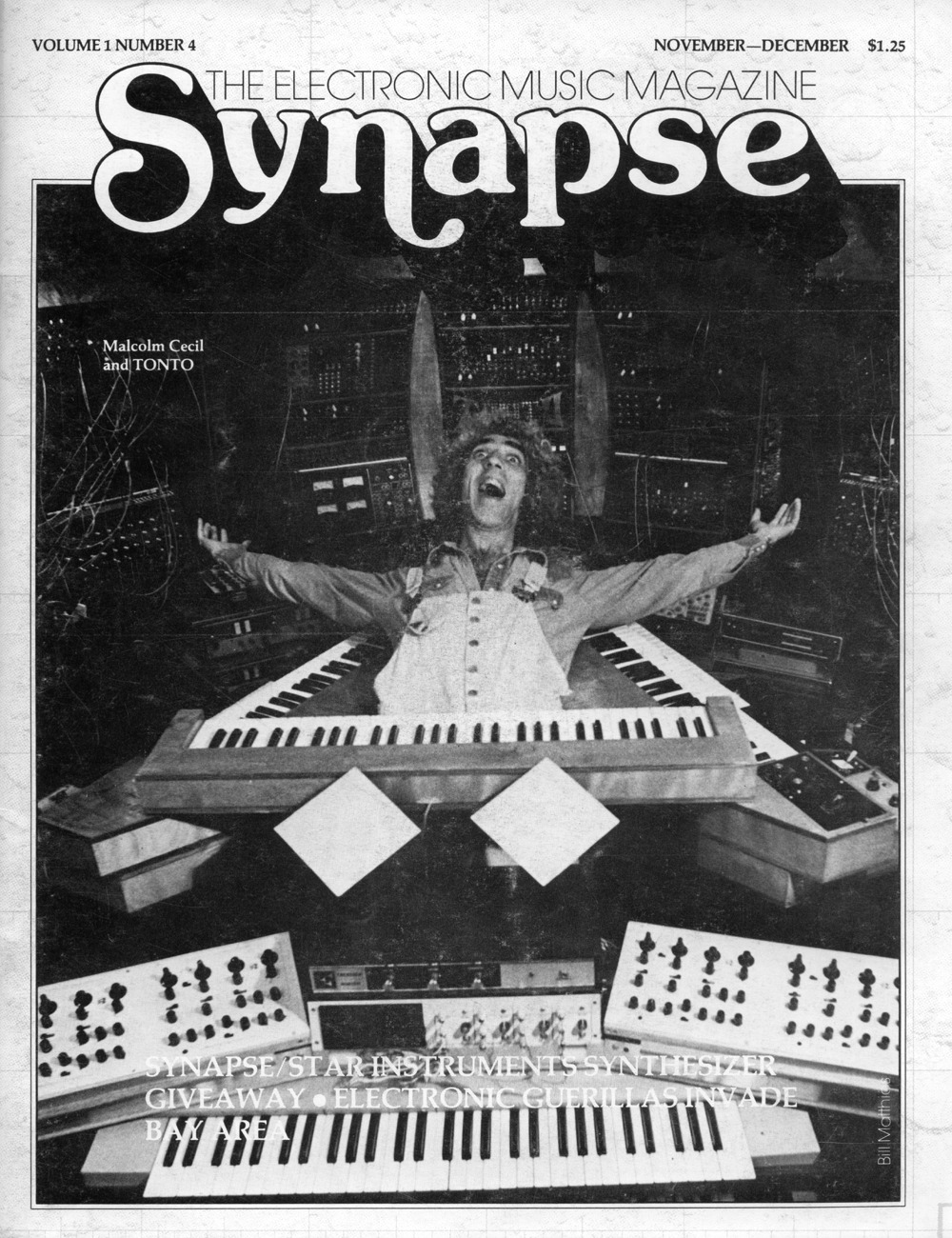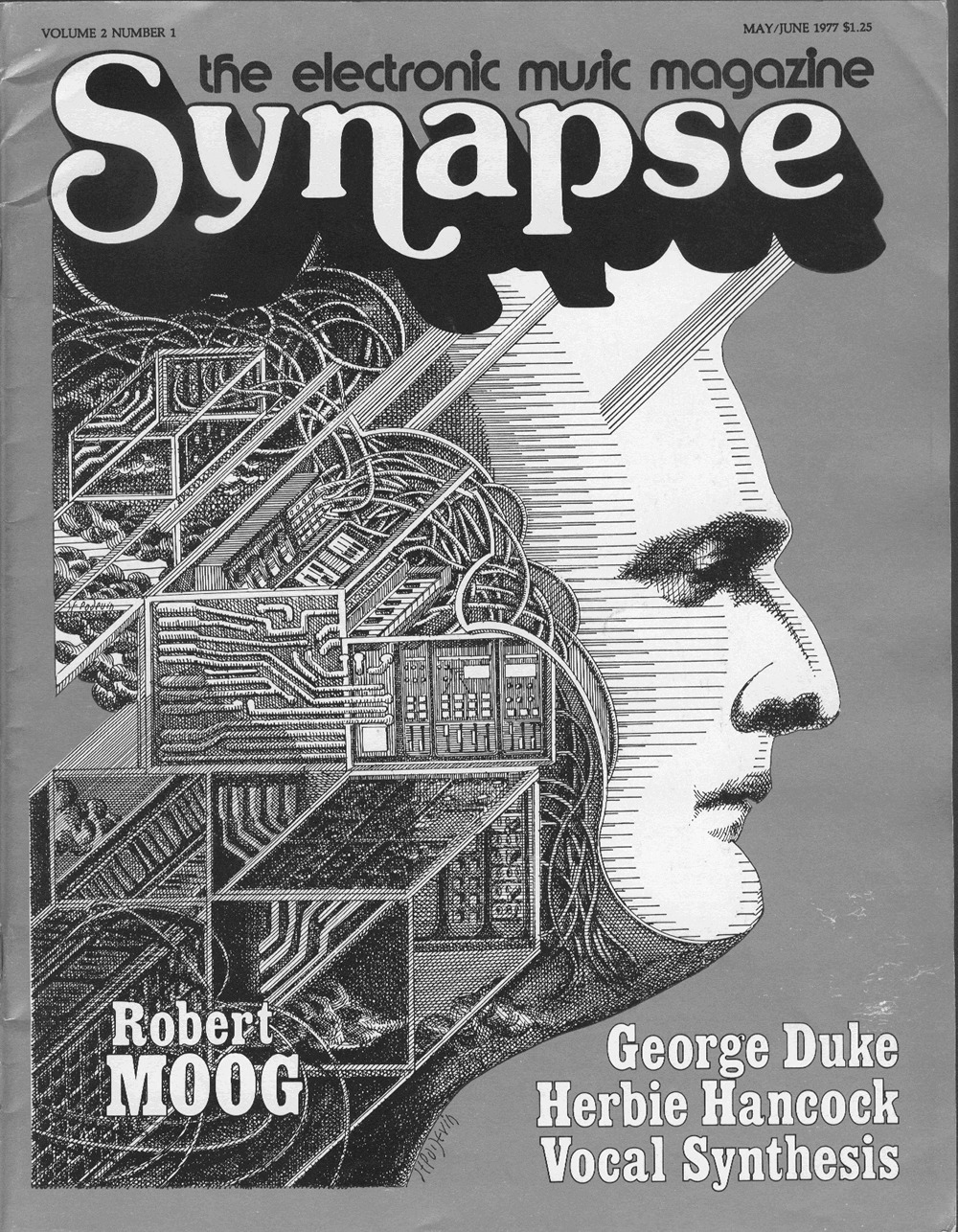Synapse: The Electronic Music Magazine (1976-1979)
Filed under magazine | Tags: · computer music, computing, electroacoustic music, electronic music, music, sound art, sound recording, sound synthesis



Synapse: The Electronic Music Magazine (later Synapse: International Electronic Music) was a bi-monthly American magazine about synthesizers and electronic music published March 1976 to June 1979. During an era when commercial synthesizers were still pretty new and mostly DIY, Synapse was notable for its high production values, interviews with famous musicians, and articles by well-known writers.
The production team consisted of editor Douglas Lynner, art director Chris August, photographer Bill Matthias and managing editors Colin Gardner and Melodie Bryant. After 14 issues they ran out of money and closed down.
The magazine issues have been scanned and posted online by its founder Cynthia Webster at Cyndustries.
Volume 1, Number 2, April/May 1976 (added on 2019-8-11 via diophantine.net HT Ezra J. Teboul)
Volume 1, Number 3, September/October 1976
Volume 1, Number 4, November/December 1976
Volume 1, Number 5, January/February 1977
Volume 1, Number 6, March/April 1977
Volume 2, Number 1, May/June 1977
Volume 2, Number 2, July/August 1977
Volume 2, Number 3, November/December 1977
Volume 2, Number 4, January/February 1978
Volume 2, Number 5, March/April 1978
Volume 2, Number 6, Summer 1978
Volume 3, Number 1, January/February 1979
Volume 3, Number 2, Summer 1979
GIFs (on Cyndustries.com, via Internet Archive)
Armin Medosch: Automation, Cybernation and the Art of New Tendencies, 1961-1973 (2012)
Filed under thesis | Tags: · 1960s, 1970s, art, art history, computer art, computing, cybernetics, informational capitalism, media art, politics, technology, yugoslavia
“My research investigates exhibitions as sites of research and appraises the possibilities and contradictions of a progressive and socially engaged media art practice. The international art movement New Tendencies (NT) (1961-1973) provides the material evidence through its exhibitions, symposia, artworks, catalogues, newsletters and artist’s statements. The basic methodological assumption behind my research is that new insights are gained by questioning the various interdependencies between NT and historical change.
NT was searching for a synthesis between socialist emancipation and artistic modernism by proposing to replace the notion of art with visual research. The project emerged in Zagreb, capital of Croatia which was then part of Yugoslavia, a Socialist nation which did not belong to the Eastern bloc and experimented with market Socialism combined with social self-management and self-government. Yugoslavia’s unique role between the hegemonic power blocs made it possible that an international, humanistic, and progressive art movement could emerge from its territory.
With every exhibition and conference NT articulated its artistic position and set itself into relation with the respective techno-economic paradigm. NT began during the height of Fordism, continued during Fordism’s moment of crisis in 1968, and ended when a new paradigm – informational capitalism – started to develop from within the old one. In this historical context, my hypothesis is that NT’s exploration of participatory art stands in direct relation to the rise of automation and cybernation in society. A further layer of inquiry is the historically changing relationship between manual and intellectual labour and how art addresses it.
By contextualising NT my research contributes a new dimension to the history of media art. Through the chosen methodology, a new understanding is gained not only of this important art movement but of the general dynamics of media art in the second half of the 20th century.” (Abstract)
Doctoral thesis
Arts and Computational Technology, Goldsmiths, University of London
369 pages
PDF, PDF (updated on 2015-7-12)
Comment (0)Sadie Plant: Zeros + Ones: Digital Women and the New Technoculture (1997)
Filed under book | Tags: · computing, cyberfeminism, feminism, history of computing, history of technology, machine, technology, women

“Zeros and Ones is an intelligent, provocative and accessible investigation of the intersection between women, feminism, machines and in particular, information technology. Arguing that the computer is rewriting the old conceptions of man and his world, it suggests that the telecoms revolution is also a sexual revolution which undermines the fundamental assumptions crucial to patriarchal culture. Historical, contemporary and future developments in telecommunications and in IT are interwoven with the past, present and future of feminism, women and sexual difference, and a wealth of connections, parallels and affinities between machines and women are uncovered as a result. Challenging the belief that man was ever in control of either his own agency, the planet, or his machines, this book argues it is seriously undermined by the new scientific paradigms emergent from theories of chaos, complexity and connectionism, all of which suggest that the old distinctions between man, woman, nature and technology need to be radically reassessed.”
Publisher Fourth Estate, 1997
ISBN 1857026985, 9781857026986
305 pages
Reviews: Nina Wakeford (New Scientist, 1997), Publishers Weekly (1997), McKenzie Wark (The Australian, 1998), Gyrus (Dreamflesh, 2008), Laura Lee (n.d.), Marta I. González García (Revista del Libros, 2001, ES).
PDF (23 MB, updated on 2019-6-18)
Comment (0)
